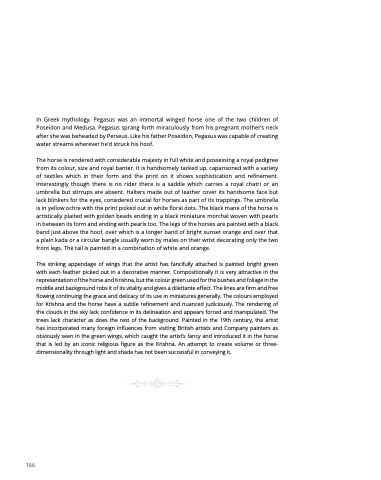Page 172 - Eye of the beholder
P. 172
In Greek mythology, Pegasus was an immortal winged horse one of the two children of Poseidon and Medusa. Pegasus sprang forth miraculously from his pregnant mother’s neck after she was beheaded by Perseus. Like his father Poseidon, Pegasus was capable of creating water streams wherever he’d struck his hoof.
The horse is rendered with considerable majesty in full white and possessing a royal pedigree from its colour, size and royal banter. It is handsomely tacked up, caparisoned with a variety of textiles which in their form and the print on it shows sophistication and refinement. Interestingly though there is no rider there is a saddle which carries a royal chatri or an umbrella but stirrups are absent. Halters made out of leather cover its handsome face but lack blinkers for the eyes, considered crucial for horses as part of its trappings. The umbrella is in yellow ochre with the print picked out in white floral dots. The black mane of the horse is artistically plaited with golden beads ending in a black miniature morchal woven with pearls in between its form and ending with pearls too. The legs of the horses are painted with a black band just above the hoof, over which is a longer band of bright sunset orange and over that a plain kada or a circular bangle usually worn by males on their wrist decorating only the two front legs. The tail is painted in a combination of white and orange.
The striking appendage of wings that the artist has fancifully attached is painted bright green with each feather picked out in a decorative manner. Compositionally it is very attractive in the representation of the horse and Krishna, but the colour green used for the bushes and foliage in the middle and background robs it of its vitality and gives a dilettante effect. The lines are firm and free flowing continuing the grace and delicacy of its use in miniatures generally. The colours employed for Krishna and the horse have a subtle refinement and nuanced judiciously. The rendering of the clouds in the sky lack confidence in its delineation and appears forced and manipulated. The trees lack character as does the rest of the background. Painted in the 19th century, the artist has incorporated many foreign influences from visiting British artists and Company painters as obviously seen in the green wings, which caught the artist’s fancy and introduced it in the horse that is led by an iconic religious figure as the Krishna. An attempt to create volume or three- dimensionality through light and shade has not been successful in conveying it.
166


